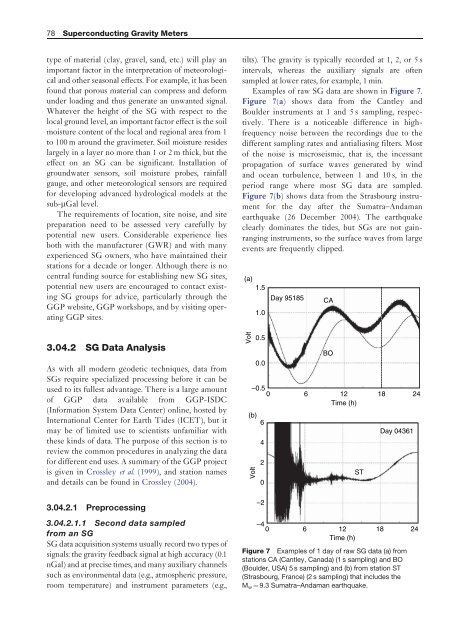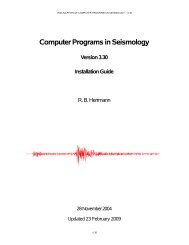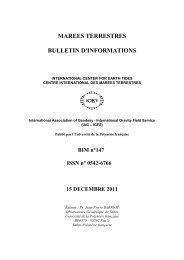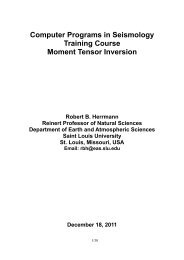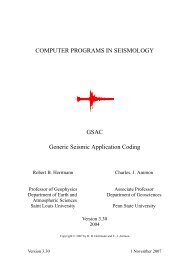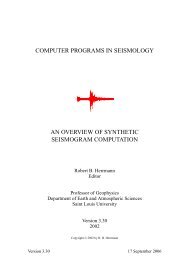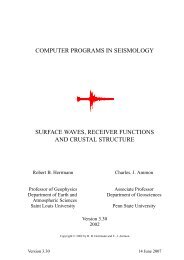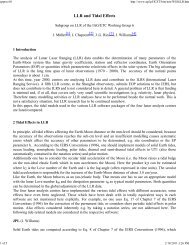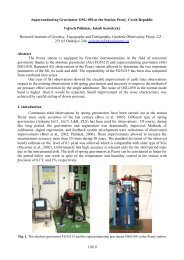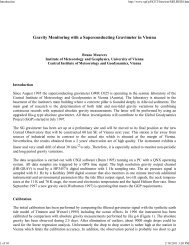3.04 Gravimetric Methods – Superconducting Gravity Meters
3.04 Gravimetric Methods – Superconducting Gravity Meters
3.04 Gravimetric Methods – Superconducting Gravity Meters
You also want an ePaper? Increase the reach of your titles
YUMPU automatically turns print PDFs into web optimized ePapers that Google loves.
78 <strong>Superconducting</strong> <strong>Gravity</strong> <strong>Meters</strong><br />
type of material (clay, gravel, sand, etc.) will play an<br />
important factor in the interpretation of meteorological<br />
and other seasonal effects. For example, it has been<br />
found that porous material can compress and deform<br />
under loading and thus generate an unwanted signal.<br />
Whatever the height of the SG with respect to the<br />
local ground level, an important factor effect is the soil<br />
moisture content of the local and regional area from 1<br />
to 100 m around the gravimeter. Soil moisture resides<br />
largely in a layer no more than 1 or 2 m thick, but the<br />
effect on an SG can be significant. Installation of<br />
groundwater sensors, soil moisture probes, rainfall<br />
gauge, and other meteorological sensors are required<br />
for developing advanced hydrological models at the<br />
sub-mGal level.<br />
The requirements of location, site noise, and site<br />
preparation need to be assessed very carefully by<br />
potential new users. Considerable experience lies<br />
both with the manufacturer (GWR) and with many<br />
experienced SG owners, who have maintained their<br />
stations for a decade or longer. Although there is no<br />
central funding source for establishing new SG sites,<br />
potential new users are encouraged to contact existing<br />
SG groups for advice, particularly through the<br />
GGP website, GGP workshops, and by visiting operating<br />
GGP sites.<br />
tilts). The gravity is typically recorded at 1, 2, or 5 s<br />
intervals, whereas the auxiliary signals are often<br />
sampled at lower rates, for example, 1 min.<br />
Examples of raw SG data are shown in Figure 7.<br />
Figure 7(a) shows data from the Cantley and<br />
Boulder instruments at 1 and 5 s sampling, respectively.<br />
There is a noticeable difference in highfrequency<br />
noise between the recordings due to the<br />
different sampling rates and antialiasing filters. Most<br />
of the noise is microseismic, that is, the incessant<br />
propagation of surface waves generated by wind<br />
and ocean turbulence, between 1 and 10 s, in the<br />
period range where most SG data are sampled.<br />
Figure 7(b) shows data from the Strasbourg instrument<br />
for the day after the Sumatra<strong>–</strong>Andaman<br />
earthquake (26 December 2004). The earthquake<br />
clearly dominates the tides, but SGs are not gainranging<br />
instruments, so the surface waves from large<br />
events are frequently clipped.<br />
(a)<br />
1.5<br />
Day 95185<br />
1.0<br />
CA<br />
<strong>3.04</strong>.2 SG Data Analysis<br />
As with all modern geodetic techniques, data from<br />
SGs require specialized processing before it can be<br />
used to its fullest advantage. There is a large amount<br />
of GGP data available from GGP-ISDC<br />
(Information System Data Center) online, hosted by<br />
International Center for Earth Tides (ICET), but it<br />
may be of limited use to scientists unfamiliar with<br />
these kinds of data. The purpose of this section is to<br />
review the common procedures in analyzing the data<br />
for different end uses. A summary of the GGP project<br />
is given in Crossley et al. (1999), and station names<br />
and details can be found in Crossley (2004).<br />
<strong>3.04</strong>.2.1 Preprocessing<br />
Volt<br />
0.5<br />
0.0<br />
BO<br />
<strong>–</strong>0.5<br />
0 6 12<br />
Time (h)<br />
(b)<br />
6<br />
Volt<br />
4<br />
2<br />
0<br />
<strong>–</strong>2<br />
ST<br />
18 24<br />
Day 04361<br />
<strong>3.04</strong>.2.1.1 Second data sampled<br />
from an SG<br />
SG data acquisition systems usually record two types of<br />
signals: the gravity feedback signal at high accuracy (0.1<br />
nGal) and at precise times, and many auxiliary channels<br />
such as environmental data (e.g., atmospheric pressure,<br />
room temperature) and instrument parameters (e.g.,<br />
<strong>–</strong>4<br />
0 6 12<br />
Time (h)<br />
18 24<br />
Figure 7 Examples of 1 day of raw SG data (a) from<br />
stations CA (Cantley, Canada) (1 s sampling) and BO<br />
(Boulder, USA) 5 s sampling) and (b) from station ST<br />
(Strasbourg, France) (2 s sampling) that includes the<br />
M w ¼ 9.3 Sumatra<strong>–</strong>Andaman earthquake.


